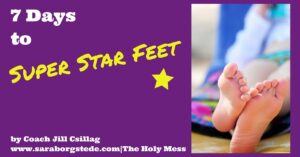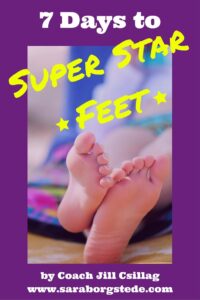
7 Days to Super Star Feet
Finding the Right Shoe for YOU
Shopping for a well-fitted shoe can be extremely confusing and frustrating at best, and may make you feel like Cinderella when she was searching for her elusive glass slipper.
There is so much information to consider the correct shoe for you. Minimal or standard drop, high cushion or low cushion, motion control or stability, pronator or supinator… It can be completely overwhelming!
There is nothing worse than spending a good chunk of money on a shoe that you think is perfect for you, only to discover the opposite is true when your dogs are barking after only one wear!
The best advice I can give you when it comes to finding the proper shoe for you is to BE FITTED FOR IT.
I know this may be an archaic idea to some of you, but believe me, it really ensures that you are in the right level of support. You need to find a store that uses old fashioned tools like a brannock, experience, and common sense.
A trained fitting specialist will inspect your feet, ask you a lot of questions, measure for sizing and support, and perform a gait analysis in the shoes they determine are best for you. They won’t pull shoes for you because of color or cuteness; rather, their primary goal is to find a shoe that will not only provide cushion, but support your specific gait type.
Here’s a quick lowdown of the most popular types of athletic shoes:
- Minimal– A zero to low drop shoe, think barefoot type shoes, best for supinators
- Neutral – Cushion without any medial posting to prevent pronation, best for supinators
- Light Support – Has a small amount of medial posting to prevent pronation
- Moderate Support – Contains a larger, beefier medial posting to prevent pronation
- Stability – Much more robust on the medial posting, stiffer foam on outsole for excessive pronators
- Motion Control – The brick of athletic shoes. Very stiff, generally much heavier, with different types of posting for severe pronators. Oftentimes you will see terminology such as “progressive diagonal rollbar” on a motion control shoe. Not many folks require the robust support of a motion control shoe.
FYI – Medial posting refers to the foam and/or plastic shafts that you will commonly see on the medial side (side facing in) on your shoes. Sometimes the foam will be a darker color, or have a pattern to it. I encourage you to inspect your shoes and feel the difference in the foam that surrounds the upper. Generally you will find this to be much more dense and stiff on the medial side of the shoe, unless you are in the neutral category.
Wearing the wrong type of shoe for your gait can cause a myriad of problems, as your body will be out of alignment if you are pronating in or supinating out. Think about it – if your feet roll in as you walk, your ankles, knees, hips and back will all be askew. The same rings true if your foot has a tendency to roll out, and you are wearing a shoe with too much support, thereby pushing your alignment out even further.
I am a firm believer in wearing the correct type of supportive shoe, REGARDLESS of what you are doing. It doesn’t matter if you aren’t running or walking. Even if you are standing around at work or shopping at the grocery store, your feet and overall alignment will be affected by the shoe you wear.
I also encourage you to make sure you are wearing the correct size. Nine times out of ten most people are wearing an athletic shoe that is too short. Do you suffer from black toenails or have you lost toenails in the past? This is a sure fire sign that your shoe is too short. Remember that your feet will swell the longer you are in the shoe, and we all see maximum swelling around 5 pm. It’s better to shop for shoes later in the day, if possible, to ensure you are wearing the correct size.
Diabetics need to be especially sensitive to wearing the correct size shoe as well, as blood flow is usually compromised to the lower extremities. When you think about the distance from your heart to your toes, you want to do everything possible not to jeopardize consistent blood flow to the foot and toes.
There is typically no break-in period in a running or walking shoe. Shoes should feel like heaven straight out of the box. A running shoe should feel like a natural extension of your foot, as if you aren’t even aware of its presence on your foot.
When you are shopping for a shoe, I encourage you to ask as many questions as you can to the associate helping you. Please keep in mind that the internet is a great source of information, but just because you read a review about one particular shoe, it may not be the right shoe for YOU.
We are all unique, and everyone interprets the fit and feel of a shoe in their own way. There is no one size fits all in the world of athletic shoes, and no two feet are alike either!
Shop around and search for a store that caters to your needs and is ready to address any questions or concerns you may have. You should never feel rushed in the fitting process either, as it takes time to review the fit and feel of each shoe you try on. Most likely, a local business (rather than a chain of department stores) will offer the best experience. This is generally all that they do and they specialize in the process.
Remember, once you find the perfect shoe for you at that store, please continue to patronize them with your business. Resist the urge to re-order the shoe they fit you in originally on the internet, as they spent a lot of time helping you find the perfect shoe. You can reward that expertise by being a regular shopper at their establishment. You will also be supporting your local economy at the same time!
Happy shoe hunting!
Coach Jill’s Favorite Recommended Super Feet Resources:
















Leave a Reply